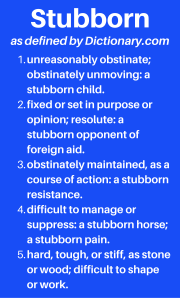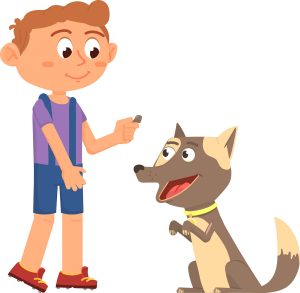Help! My Dog Is Stubborn!
By Don Hanson, PCBC-A, BFRAP
 < A version of this article was published in the April & May 2022 issue of Downeast Dog News>
< A version of this article was published in the April & May 2022 issue of Downeast Dog News>
< Updated 29AUG22 >
< A short link for this page – https://bit.ly/HelpStubborn >
What Is Stubborn?
I have often heard a prospective or existing student say, “Can you help me? My dog is so stubborn.” I’m not a fan of the word “stubborn.” Too often, it is used in a derogatory manner as a result of frustration when something or someone is not  behaving in a way that is perceived as desirable. Yet it is a word that most of us, myself included, use occasionally. “Stubborn” is used between spouses, co-workers, parents, children, and yes, by people describing their dogs.
behaving in a way that is perceived as desirable. Yet it is a word that most of us, myself included, use occasionally. “Stubborn” is used between spouses, co-workers, parents, children, and yes, by people describing their dogs.
Before starting this article, I looked at several definitions for “stubborn” and finally settled on one from Dictionary.com. All of the definitions reviewed were revealing in that they suggested the response of the “stubborn” party was “unreasonable.”This indicates a lack of understanding why another being might choose not to do something we want.
Empathy is essential when interacting with anyone, but especially when working with a different species, such as a dog, which has very different needs and communication methods than humans. Understanding these needs and what our dogs communicate to us is crucial to empathizing with them. Furthermore, if we want to have the best relationship possible with our dogs, we need to work diligently toward meeting their species-specific needs. [ FMI – http://bit.ly/Brambells-1-5 ]
Let’s examine the simple exercise of teaching a dog to sit and examine why even a well-trained dog might choose not to “sit” when asked to do so.
Anxious/Afraid/Hyper-excited – No living thing learns or responds well when stressed. If your dog is under stress for any reason, it is not a good time to train; it  does not matter if the stress is rooted in fear or excitement. When under stress, the part of the brain responsible for learning is deactivated to allow one to focus on survival. Even if your dog is exceptionally well trained, it may be unrealistic to expect them to respond reliably when they are worried or highly aroused. [ FMI – http://bit.ly/Canine-Stress ]
does not matter if the stress is rooted in fear or excitement. When under stress, the part of the brain responsible for learning is deactivated to allow one to focus on survival. Even if your dog is exceptionally well trained, it may be unrealistic to expect them to respond reliably when they are worried or highly aroused. [ FMI – http://bit.ly/Canine-Stress ]
Physical Discomfort or Illness – Think of the last time you were hurting, nauseous, or tired. The odds are that it caused you to move slower or possibly not to move at all. Unfortunately, our dogs experience injuries and exhaustion just as people do, and this may cause them to appear to be “stubborn.” Additionally, some trainers use tools designed to cause physical pain (shock, prong, and choke collars). Pain, whether from an injury or intentionally inflicted by a person, will cause stress, which may cause a dog to shut down, act “hyper,” or respond aggressively.
 Not all physical discomfort comes from pain. I have known more than one dog that refused to lie down on a cold floor or sit on hot asphalt. My dog Muppy will choose not to go outside during heavy rainfall. The anatomy of some breeds also makes certain positions, such as sitting or lying down, more or less comfortable. Is it fair to say your dog is “stubborn” for refusing to do certain behaviors when they are in physical or emotional distress? Of course not.
Not all physical discomfort comes from pain. I have known more than one dog that refused to lie down on a cold floor or sit on hot asphalt. My dog Muppy will choose not to go outside during heavy rainfall. The anatomy of some breeds also makes certain positions, such as sitting or lying down, more or less comfortable. Is it fair to say your dog is “stubborn” for refusing to do certain behaviors when they are in physical or emotional distress? Of course not.
Lack of Understanding/Training – Have you ever started to learn something and were then asked to use that knowledge before you were ready? Was that stressful? Over the years, I have encountered people who expect their dog to “get it” with only minimal training. Unfortunately, when the dog fails to respond, they blame the dog.
Dogs are discriminators, which means that training a dog requires teaching behaviors in a wide variety of environments and situations while gradually increasing distractions for many repetitions. Training a dog for an hour a week in a six-week training class is just the beginning of a training program that would benefit almost every dog. Achieving reliable responses from a dog requires that you, the trainer, be knowledgeable and skilled in canine behavior, body language, and the selection and use of rewards. The treats you use and the timing of the treat delivery are essential to getting reliable behavior. Working with a professional and credentialed dog training instructor can be very helpful. [ FMI – http://bit.ly/HowToSelectADogTrainer ]
Your Challenge
If your dog is not behaving as you desire, before you call them “stubborn,” ask yourself why that might be. Is your dog afraid or over-excited? Could they be experiencing physical or emotional distress? Do they understand what you want? You and the dog will get more frustrated with one another until you address the core issues for their lack of response.
I believe that a dog that appears to be stubborn is under stress or in pain, has had inadequate training, or is insufficiently motivated.
 Like us, our dogs need to be motivated to do things. Motivation is simply offering an incentive to another living being to do something. For many people, an example of a primary motivator is the paycheck we receive from our employers. Of course, our employer could punish us instead of paying us, but we are unlikely to show up the next day unless we’re enslaved.
Like us, our dogs need to be motivated to do things. Motivation is simply offering an incentive to another living being to do something. For many people, an example of a primary motivator is the paycheck we receive from our employers. Of course, our employer could punish us instead of paying us, but we are unlikely to show up the next day unless we’re enslaved.
Motivation can be either a reward or a punishment. With dogs, punishment as a motivator typically involves yelling or using force to cause physical pain, fear, or emotional distress. Pain and fear can be highly motivating the instant they are applied. However, using punishment as  a motivator will likely irreparably damage the relationship between the punisher and the victim. It can make the mere presence of the punisher a demotivator for life. Thus, choosing punishment as a motivator is not only cruel; it is an inefficient and unproductive way to train. This is one of many reasons why the Pet Professional Guild (PPG), American Animal Hospital Association (AAHA), and the American Society of Animal Behavior (AVSAB) and many trainers recommend punishment NEVER be used to train or care for a dog. [ FMI – https://bit.ly/Pos_HumaneTraining ]
a motivator will likely irreparably damage the relationship between the punisher and the victim. It can make the mere presence of the punisher a demotivator for life. Thus, choosing punishment as a motivator is not only cruel; it is an inefficient and unproductive way to train. This is one of many reasons why the Pet Professional Guild (PPG), American Animal Hospital Association (AAHA), and the American Society of Animal Behavior (AVSAB) and many trainers recommend punishment NEVER be used to train or care for a dog. [ FMI – https://bit.ly/Pos_HumaneTraining ]
Many types of rewards can motivate dogs: food, play, and physical touch are at the top of the list. However, contrary to popular belief, praise does not qualify as a reward in and of itself. Back in the seventies, a group of Monks wrote a book suggesting that you should never use food as a reward  with your dog. However, several studies have since confirmed that food has more value as a reward than either praise or touch.
with your dog. However, several studies have since confirmed that food has more value as a reward than either praise or touch.
Food is a great choice when training dogs. Professional animal trainers use it all the time. At Sea World, the animals are trained with food and continue to get food as a reward for their performances long after they have been taught. Our employer doesn’t stop paying us after we learn how to do our jobs. So why would we ever stop rewarding our dog for doing something we want?
While play can be valuable as a reward, I find it less efficient than food. Since training is all about repetition, efficiency is critical. I often get as many 5 to 10 behaviors per minute when using food while training a dog. In contrast, one must refocus the dog after every play session when using play as a reward. It is like coming in from recess when we were in grade school; the teacher had to get us settled before they could start teaching us. However, play can be a great reward after training a dog.
must refocus the dog after every play session when using play as a reward. It is like coming in from recess when we were in grade school; the teacher had to get us settled before they could start teaching us. However, play can be a great reward after training a dog.
Food is a great motivator, but we must remember that some foods are more motivating than others, especially if what we are asked to do is difficult or something we do not enjoy. Therefore we must identify the food that our dog likes best.
While many dogs are known to eat almost anything (even what we consider inedible), some can be finicky. In my experience, treats that smell and taste of meat are usually valued higher by our canine companions. If one of my students doesn’t believe me, I suggest we call his dog at the same time. The student uses pieces of the dog’s kibble while I use some leftover roast beef or chicken. The dog races to me, and voila, the student gets it. The point is that treat value matters. So don’t be stingy to protect your ego.
Teaching a dog to sit can be relatively easy since most dogs sit anyway of their own accord. With “sit,” we are just training our dogs to do something they  already do naturally. When initially teaching the “sit” in a low distraction environment, I will probably use a mixture of low to medium-value treats (kibble or other treats with very little meat content) with a high-value treat thrown in at random for an exceptional response. However, when training in a more distracting environment, for example, in a group training class or in a park where children are playing, I will probably need to increase the value of the treats to be successful. Don’t let your ego get in the way of helping your dog be successful; use better treats when you need to!
already do naturally. When initially teaching the “sit” in a low distraction environment, I will probably use a mixture of low to medium-value treats (kibble or other treats with very little meat content) with a high-value treat thrown in at random for an exceptional response. However, when training in a more distracting environment, for example, in a group training class or in a park where children are playing, I will probably need to increase the value of the treats to be successful. Don’t let your ego get in the way of helping your dog be successful; use better treats when you need to!
Training recall is more difficult to teach than sit because we ask the dog to go against its instincts. Often when we most want our dogs to come, they are simultaneously distracted by something extremely motivating (a taunting squirrel or anything else they find very tempting). Therefore, if we are going to be successful, we must be even more enticing than the squirrel. For this reason, I always use special, high-value treats when training recall. Even after my dog has a reliable recall, I continue to reward them every time.
To learn how to turn your “allegedly stubborn” dog into your best friend for life, check out my article There Are No Stubborn Dogs–12 Steps to Becoming Best Friends for Life at – https://bit.ly/12Steps-BestFriendsForLife
________________________________________________________________________
Don Hanson lives in Bangor, Maine, where he is the co-owner of the Green Acres Kennel Shop ( greenacreskennel.com ) and the founder of ForceFreePets.com, an  online educational resource for people with dogs and cats. He is a Professional Canine Behavior Consultant (PCBC-A) accredited by the Pet Professional Accreditation Board (PPAB) and a Bach Foundation Registered Animal Practitioner (BFRAP). Don is a member of the Pet Professional Guild (PPG), serving on the Board of Directors and Steering Committee and chairing the Advocacy Division. He is also a founding director of Pet Advocacy International (PIAI). In addition, Don produces and co-hosts The Woof Meow Show podcast, available at http://bit.ly/WfMwPodcasts/, the Apple Podcast app, and Don’s blog: www.words-woofs-meows.com. The opinions in this article are those of Don Hanson.
online educational resource for people with dogs and cats. He is a Professional Canine Behavior Consultant (PCBC-A) accredited by the Pet Professional Accreditation Board (PPAB) and a Bach Foundation Registered Animal Practitioner (BFRAP). Don is a member of the Pet Professional Guild (PPG), serving on the Board of Directors and Steering Committee and chairing the Advocacy Division. He is also a founding director of Pet Advocacy International (PIAI). In addition, Don produces and co-hosts The Woof Meow Show podcast, available at http://bit.ly/WfMwPodcasts/, the Apple Podcast app, and Don’s blog: www.words-woofs-meows.com. The opinions in this article are those of Don Hanson.
©24AUG22, Donald J. Hanson, All Rights Reserved
< Click for Copyright and Use Policy >

